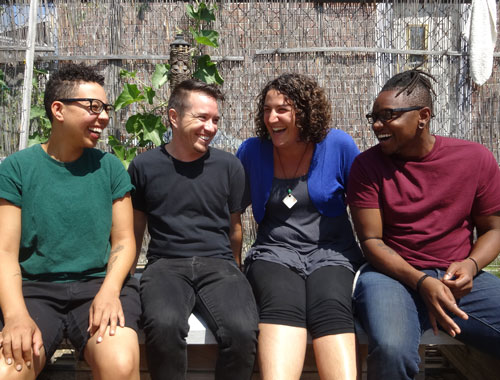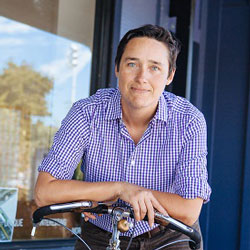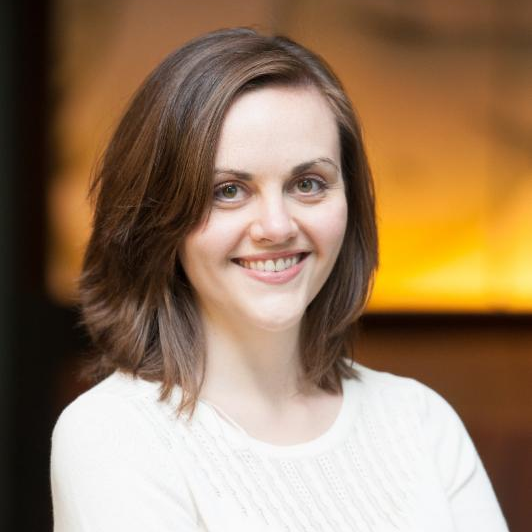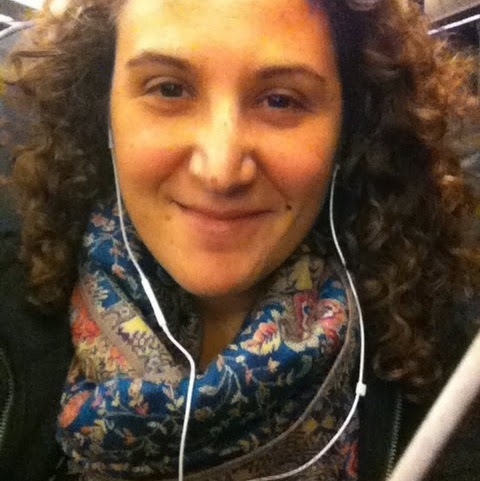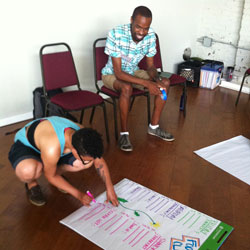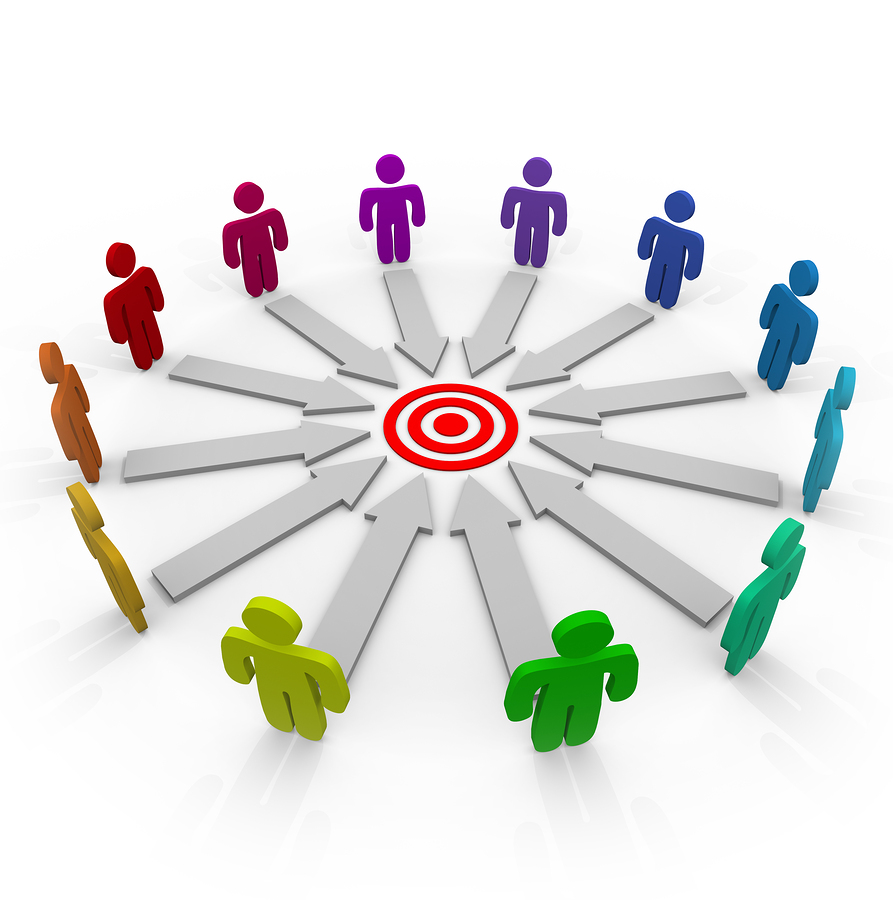
Research shows that the most effective and successful organizations and businesses are those that capitalize on diverse perspectives and strengths within their ranks. From key volunteers to paid staff to the board of directors, the biking and walking movement is full of leaders — how can we tap into that wealth of talent and initiative to create leadership structures and pipelines that build a stronger, more inclusive movement?
On our August Distance Learning Webinar, we explored these questions with several leaders who are seeking to integrate aspects of shared or distributed leadership into their organizations: Celia Kutz, co-director of Training for Change; Renee Rivera, Executive Director for Bike East Bay; and Stacy Thompson, Deputy Director at the LivableStreets Alliance.
But first let's take a step back. What is shared leadership?
One the resources that I found helpful and grounding for this conversation was a report from the Building Movement Project: Structuring Leadership: Alternative Models for Distributing Power and Decision-Making in Nonprofit Organizations. According to them: "Shared leadership describes a model in which the top level of executive leadership is shared internally by two or more people (for example, a co-directorship). Distributed leadership is a model in which there is one person in the executive role, but decision-making is consistently and methodically pushed down to other levels in the organization (for example, strong program directors)."
Below are so key aspects we addressed in our discussion — lightly edited for easier comprehension in the written form. To listen to the full conversation, members can access the recording in the Alliance Resource Library here.
So why talk about leadership — and the way it present in an organization — anyway?
Celia Kutz, Co-director, Training for Change (pictured right, blue sweater, with colleagues): Training for Change, as an organization, has a very interesting history in terms of transitioning from a very dynamic and charismatic founder. When he stepped away in 2006, the folks drawn to the work and leading the training of trainers thought, "This stuff is too good to let go." So it rose to an organizational level. Now Training for Change has a staff of three with trainings across the country. So it’s been a central conversation for us: How are we sharing the load in the responsibilities and roles we have.
It’s so often that power can get concentrated into one individual or one department and that can steamroll into a whole host of complicated feelings or projections or misunderstanding about how things are functioning in the organization. Whether it’s the power of writing checks, the power of hiring or discerning programming, each decision has its own weight. So it’s important to get clear on how we're relating to each other in our roles, and how we honor the different roles we have without getting caught into the titles or labels or assumptions we make because of the structure that we’re in.
It’s always a great conversation to have in your organization: “Who’s doing what here, and how do we honor and distribute responsibility in a way that makes sense for us?” Because every organization is different.
Shared leadership from an Executive Director perspective
Renee Rivera, Executive Director, Bike East Bay (pictured right): My folks were hippies and I grew up on communes, so I have memories of being in all-night community meetings, sleeping curled up under a coffee table while the adults processed on and on and on. So I’m a big believer that traditional hierarchy can be very efficient and very nimble and work very well for an organization. But [shared leadership] is an area I’ve been very interested in exploring and I come to it with my own perspective. I am very much the traditional ED — everyone reports to me or someone else in the hierarchy. But we just went through a strategic planning process and it was a watershed moment.
I had been thinking a lot about my own role and struggling with burnout from carrying the responsibility for all the fundraising and decision-making and making sure we make our budget and all of those things. I had been working with a coach leading up to strategic planning process, and had the opportunity through that process to involve all my staff and all my board in a way that allowed them to really step up into leadership in each of their areas in the planning process, such that it wasn’t just myself and a facilitator but a team of over 20 leader facilitators who worked through that process. It was something that helped me see the power of having everyone really inhabiting leadership and owning the process.
Since then, that has translated into working together differently as a staff. Now other folks on my team share the fundraising responsibilities, not because they’re development, but so all of us are building those key relationship for the organization. Now the things that keep me up at night get brought to the table and get discussed and that helps relieve the burden of what I was facing as ED that was really starting to make my job difficult…
One of the things I was working on with a coach was to think about my own role and my own strengths as a leader. And I started to see that I came to leadership with a lot of strength in facilitation and coaching and I’ve started to see my role as ED as more of a coach and facilitator rather than director. I don’t think of myself so much these days as a director.
Shared leadership from a Deputy Director perspective
Stacy Thompson, Deputy Director, LivableStreets (pictured right): I give a lot of credit to LivableStreets. Jackie Douglas, who is the ED had a similar trajectory to that of Renee. She was the first full-time, paid employee seven years ago and the organization has grown from 1 to 4 staff. There was a moment during some staff turnover that the organization at the board level said Jackie’s been here for seven years and while she’s built a great organization with a lot of support and a lot of great work going on, she doesn’t have a peer. If Jackie walks away, she has the relationships and the key initiatives, she understands the day to day and is working and thinking strategically. We need to, not just get her the support she needs, but create a peer model. They were also thinking, LivableStreets is continuing to grow — what are the skills our ED doesn’t have?
So there was some very thoughtful conversation to not rehire the exact position as it existed previously and instead assess the organization with growth in mind. In that process the Deputy Director position was created and I was hired. I had no walking and biking experience; I was working at a national organization. What I could do was bring communications expertise, fundraising expertise, specifically with corporations, and nonprofit organization management. So the idea was that I could bring qualities to the organization didn’t exist as robustly, and I could be Jackie’s partner. She’s still the ED and the ultimate decision maker, but there’s a sense of responsibility for the organization on my plate and I'm directly responsible for large pieces of day-to-day work, in terms of managing communications and our largest event. But there was a concerted decision and support at the board level to say “We trust you, we support you and you bring skills that the organization didn’t have.” I do think that’s unique and has made for a more efficient and growing organization.
Shared leadership from a Co-director perspective
Celia Kutz, Co-director, Training for Change: I’ve been in a co-director model the last nine years or so and one of the greatest strengths is what Stacy and Renee said about distributed responsibility in terms of bearing weight on one individual. I’ve found that having someone to talk things through with, where you’re sharing in the decision, enhances and makes me make better decisions, partially because I’m forced to explain and explore a lot of different options. My current co-director and I, we don’t always agree. We look at decisions from different perspectives and we’re also of different racial backgrounds, which deeply enhances the ways we look at the world. He brings perspective from his cultural background that I don’t have first-hand experience in and wouldn’t assume to know. That’s really made it possible for us to reach a diverse demographic in our programming and trainers, because people relate to people differently. When we think about funding or outreach to specific populations or on specific content, we can think about which of us does it make sense to really be moving this part of the organization forward? It almost doubles our skill set.
Right now we’re in a transition to a director model. We put a call out for a co-director but nobody stepped forward as a qualified candidate. But I also had my own discernment that it’s actually somewhat unfair and unrealistic for me to expect someone to step directly into a co-director model, when the previous co-director and I have been working together for five years and have cultivated that relationship. I actually came in as a coordinator and within a year stepped into a leadership role with the former co-director. So that’s where we’re at right now — hiring a coordinator into the position while being in dialogue with this person to say, “You know we’ve been in a co-director model; is that of interest to you?” So there’s the possibility of stepping into that role, and they’re excited about it, but it's not a determinant of who we hired and it’s not built in. It is an internal value of the kind of leadership we want and how we see the role of staff as capacity building — we’ve hired someone who we could build up their capacity in a coordinator position to emerge into a co-director role. The challenge is the ability to be flexible and responsive to what’s real in the skills of the individuals in the roles that we need. So we’ll see. It’s in our plan for the board to assess in a year to see if we will go back to a co-director model.
What does shared leadership look like in practice?
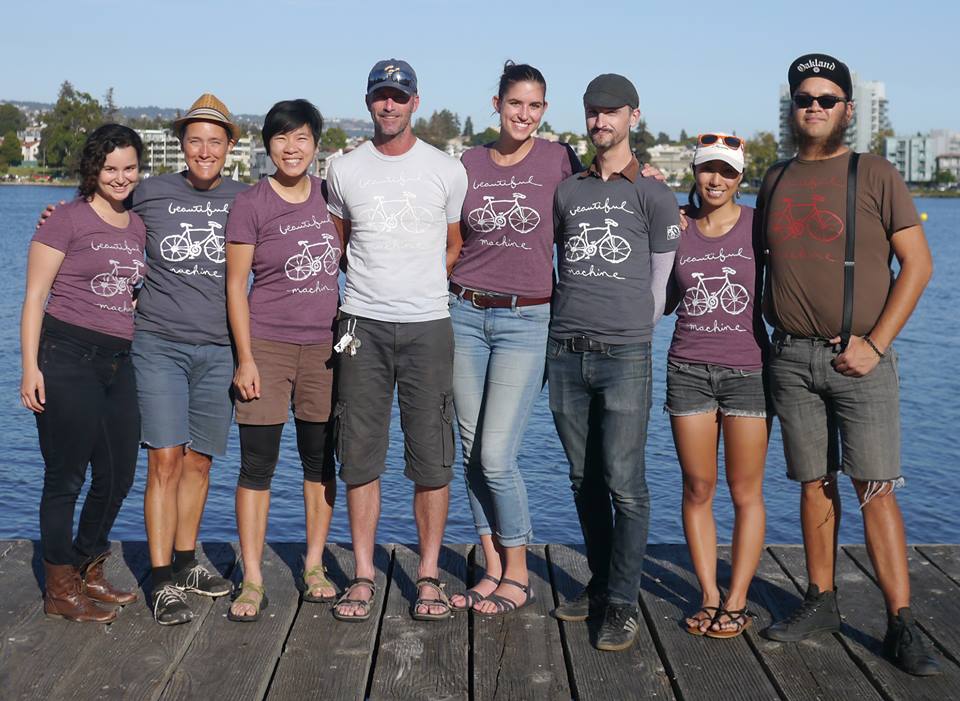
Bike East Bay staff
Renee, Bike East Bay: One tool that’s really helped us that’s very practical is around shared goals and shared accountability. We work with a quarterly goal structure called Rocks, which is something we learned at an Alliance Leadership Retreat from BTA [Bicycle Transportation Alliance in Portland]. We set Rocks quarterly, which are small sets of goals for every area, and we use weekly staff meetings to check in on our progress. We all own our areas, whether advocacy or education or fundraising, but the goals are structured around highlighting times we need help, so “Yeah, this is going well,” or “This is something that’s hitting some challenges,” or “I’m in trouble — I really need the team to help me out of this one.”
That’s had a couple of effects. One, it’s gotten me out of the role of holding people accountable. Not that each staff member isn’t accountable to me, but now we’re all accountable to each other and, in fact, I'm accountable to everyone just as much as anyone. That’s given everyone the chance to manage me, too. Every ED is pulled in a million directions. There are 50 things I could be doing today and I need to figure out which things are going to happen. So to have staff say, “Have you made that fundraising call? Have you set up that meeting?” is enormously helpful. That shared accountability has been a huge part of shared decision making — and goal setting is the structure that keeps it working day to day.
"That shared accountability has been a huge part of shared decision making — and goal setting is the structure that keeps it working day to day."
Stacy, LivableStreets: We have two processes that are helpful in distributing leadership and decision making. First, we have what I consider a fairly sophisticated communications protocol: a two-approval process. It’s doesn’t matter who you are — if the ED wants to write a letter to editor, she still needs to get two approvals from staff, board, our advocacy committee, or someone familiar with the project. So, at the highest level, there are checks and balances.
In terms of shared leadership, as communications director, it’s not my job to approve or draft every single communications that comes out of the organization. I oversee that and provide strategic guidance, especially in terms of organizational priorities but, through our advocacy committee, we’re tracking more than 80 projects throughout the Boston area. When a project comes up at a public meeting, advocates or volunteers from that committee can come back and say, “We really need to draft a comment letter” — and that person can do that. We have a template so they have guidance to write something that we can put the LivableStreets stamp on and then they send it back to our advocacy committee and say, “I want to send this, this is the timeline, I need two approvals.” So there’s a leadership opportunity for the person that is drafting that letter and for the folks reviewing it — and that whole process can happen without me being one of the approvals. So we’ve empowered a lot of people outside of our traditional staff to do that work.
At the staff level, we’ve implemented a check-in process that helps with shared leadership, too. We check in as a staff three times per week for about 15 minutes. Every week it gets jumbled up [in terms of days and times] but we all share quickly what we’re working on and things to put on the radar for everyone else. We have a white board where we write it down and people can walk up and check something off. So you get a sense of accomplishment but we’re also sharing responsibility, holding people accountable, and asking question like, “Oh, I didn’t know you’re meeting with so-and-so. That’s related to my projects in these ways.”
But in shared leadership and distributed leadership models creating a system that works for you is paramount to success. For us, it’s not a weekly meeting but these smaller steps along the way.
Celia, Training for Change: Use something when it works and, when it’s not working anymore, drop it. So many nonprofits are really committed to the committee model, even though we’ve probably all been in a committee meeting where we’ve thought “I don’t know why we’re meeting anymore.” Maybe that means having a temporary committee — using committees for a hiring process or a program where that group meets for a purpose and dissipates. I’m all for not routinizing meetings for meetings' sake. It can be a huge energy suck and, I think, sometimes gives shared leadership a bad name. That can be a tokenized attempt at shared leadership that’s not happening in more practical ways.
The importance of relationships in shared leadership
Celia, Training for Change (pictured right, TFC staff members): I think we talked a little bit about relationship building and, for me, I use the phone a lot. I jump on phone and call someone. I know all the members of our board and their specialities and I don’t usually make a decision without talking it out with at least one board member. It's been really helpful in preparing us for board meetings or meetings where decisions are being made since there’s been some organizing, some sharing of information before that decisionmaking point so people feel they’re not just being dropped into an idea but they're in the conversation.
We went through a period where that wasn’t happening, where they weren’t being consulted, they weren’t being brought into the conversation — and we were suffering. Our board was angry and didn’t understand what we were doing and we weren’t utilizing the huge resource that boards can be. So now I’m talking to any number of our board members at least every week and it’s made a huge difference. It can be something that’s easily missed: How to do that relational work that’s so hooked in with shared leadership.
Renee, Bike East Bay: Traditional hierarchy does have its moments. Sometimes it’s helpful to just make that decision as a sole decision maker. I do retain that ability, but I find that I exercise it less and less. I find that bringing a decision to the staff group results always in a better decision. Really working through our differences — because we don’t all see it the same way; we often see it very differently — those conversations are very rich and very productive for the organization.
"In a co-leadership model, it's actually really important to say, 'I don’t know. I need help.'"
Stacy, LivableStreets: I think as an ED or DD you think you have to have all the answers and you’re conditioned to fake it until you make it. In a co-leadership model, it's actually really important to say, “I don’t know. I need help.” To be self aware. Otherwise, the model doesn’t work.
Celia, Training for Change: Yeah, it’s less important to me whether it’s a director or co-director model — it’s about how you make decisions. It’s important for anyone in leadership to know that is their role: they’re tasked with making decisions sometimes. But everyone leads differently. Some people lead very definitively — they know what they see and they’re not afraid to make that decision. Other people want more discussion. So it’s not just a question of how do we share leadership in our organization. There’s also the question of how do you lead? What are the strengths and weaknesses we bring to our roles when we're working together. I think that’s an excellent way for any organization to just be reflective on the different ways you’re trying to build the work that you’re doing.
Shared leadership in small organizations
Celia, Training for Change: We’re a staff of three. I’m the only full-time person, with two coordinators who work 20 hours per week. I think it’s important to do a lot of relationship-building early on, in terms of getting to know each other and building trust. And not only understanding what drew you to this work, what will keep you involved and passionate about the job, but also what's going on in your life outside this world that pulls you out of the room? Are there issues related to family, transportation, economy, or other things that are impacting how you show up here that might be helpful for this team to know? Not [asking] in an intrusive way, but in a way that’s supportive and to get a fuller picture of who you're working with. It’s also important to find a way to not let the urge to perform early on run the show. Let the team really coalesce and come together.
Stacy, LivableStreets: If possible, try to look toward the future while being very present in the moment. At LivableStreets and a previous organization, I've watched volunteers and part-time employees become leaders in our organization. Be aware of who are your rock star volunteers and part-time employees and people who are engaged — and build leadership opportunities for them right in your organization because that could be the person you’re hiring a year from now. And if not — maybe you hire someone different — you’ve still done that work to cultivate leadership.
Renee, Bike East Bay: When you’re really small, in some ways, shared leadership comes more easily. When there’s not that many of you, it’s all hands on deck and you have to own it because you don’t have time to manage that person. Take advantage of that. When I first started five years ago, it was just me and our advocacy director. Our relationship has really evolved but there’s never been a point where we haven’t been co-owners of the key part of our work: advocacy. The two of us frequently disagree and we’ve had to really work on our relationship. That’s been the foundation of having a really shared leadership model at Bike East Bay.
"The two of us frequently disagree and we’ve had to really work on our relationship. That’s been the foundation of having a really shared leadership model at Bike East Bay."
But we’ve also had to learn as we’ve added people, how to negotiate some of the differences in ways that don’t make the rest of the staff uncomfortable — because sometimes we outright fight about things [laugh]. To me, this core relationship has helped me understand what shared leadership can be. I’d say, when you’re small that’s when you’re building it, and then the trick is to add in. As we’re getting to seven or eight people, I’m trying to figure out how does this work when have more people? How do we perpetuate this structure? That's what I’m working on right now.
Shared leadership as a step toward equity, diversity and inclusion
Celia, Training for Change: From my position of power, I’m really able to determine a lot of how we look; what’s the norm we’re setting. I have to be thoughtful about that. For me that means looking around the edges of my norm and asking, what am I not seeing in any given moment, whether that’s participants who are engaging in the programming we do or the requests we’re getting. What are the trends of who’s attracted to us and how do I look for the spaces outside of that, in terms of who isn’t getting attracted to us and how is that a reflection of how I’m showing up or just inherent in our socially inequitable world?
That’s been a big guiding post for me as a white woman in leadership of an organization doing social justice work. I’m only going to see certain things. I’m inherently blind or clueless to certain struggles or certain difficulties in the world because I haven’t experienced them. They’re not part of my lived realities. I’m not programed to automatically notice what’s happening in Baltimore or what’s happening to a lot of people, but particularly to black people, in terms of police violence. So how am I looking for things I can’t see — and how do I support my staff, which is very diverse, to bring what they see to the table to initiate shared goals. I can do diversity and inclusion work until I’m 99 years old, but there will still be things I can’t see. It’s better to be self aware and be looking outside myself and asking questions than walk blindly forward.
Stacy, LivableStreets: Diversity is a key performance indicator. Study after study shows that if you have a more diverse board, you will perform better… In the nonprofit sector that means having a larger impact... Your organization is truly better off if you’re thinking about diversifying your leadership, whether that’s race, age, educational background, or how much they know specifically about your issue. If your goal is to impact a certain region of people, you don’t need people to be biking and walking experts. They don’t need specific education. There is evidence that diversifying your base and leadership will make you better. So it can be helpful to think about that in the long term, when it can be challenging in the short term.
Renee, Bike East Bay: For me, it’s about creating an environment that makes room for a diversity of experiences and opinions. The strength that comes from that is tremendous. Sometimes I think that there’s a danger in bicycle movement that we have too many shared values — or an expectation of too many shared values. We’re so passionate about our lifestyle that sometimes we don’t see other people's values. So creating an environment in your organization that's truly welcoming of a difference of opinions and values and experiences is something that can make your organization strong in so many ways.
"Creating an environment in your organization that's truly welcoming of a difference of opinions and values and experiences is something that can make your organization strong in so many ways."
Celia, Training for Change: An organization that can get familiar with tension and discomfort is better off in the long run. When a funding source dries up or a program goes flat, if you already have personal lived experience of being in tension you’re able to weather those bigger storms better.
Listen to the full conversation in the Alliance Resource Library here — and sign up for future webinars here!

